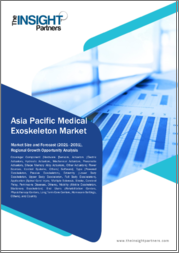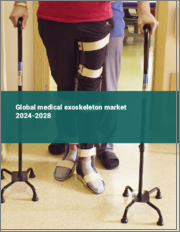
|
시장보고서
상품코드
1808326
세계의 의료용 외골격 시장 : 컴포넌트, 유형, 기술, 기능, 구조, 동작 모드, 용도, 최종 용도별 예측(2025-2030년)Medical Exoskeleton Market by Component, Type, Technology, Functionality, Structure, Mode of Operation, Application, End-Use - Global Forecast 2025-2030 |
||||||
의료용 외골격 시장은 2024년에 16억 6,000만 달러로 평가되었고, 2025년에는 18억 7,000만 달러, CAGR 12.78%로 성장하여 2030년에는 34억 2,000만 달러에 이를 것으로 예측되고 있습니다.
| 주요 시장 통계 | |
|---|---|
| 기준 연도(2024년) | 16억 6,000만 달러 |
| 추정 연도(2025년) | 18억 7,000만 달러 |
| 예측 연도(2030년) | 34억 2,000만 달러 |
| CAGR(%) | 12.78% |
의료용 외골격의 혁신적 발전 : 의료 환경 전반에 걸친 환자 이동성 및 임상 재활 전략의 새로운 시대를 구축
의료용 외골격은 생체역학, 로봇공학, 재료과학의 놀라운 융합으로, 환자와 의료진에게 전례 없는 수준의 보조 및 재활 지원을 제공합니다. 착용형 프레임워크와 정교한 제어 시스템을 통합함으로써 이 기술은 인간의 힘, 지구력, 이동성을 증폭시킵니다. 그 결과 신경학적 또는 근골격계 장애를 겪는 개인의 삶의 질이 실질적으로 개선되고, 임상 및 산업 환경의 전문가들이 뒷받침받는 역량을 갖추게 됩니다.
의학적 외골격 기술의 역동적 변혁 : 학제적 혁신을 통한 생체역학적 지원 재정의 및 사용자 경험 향상
의료용 외골격 기술의 미래는 다학제적 기술의 통합으로 역사적 과제를 극복하며 변혁적 변화를 겪고 있습니다. 적응 제어 알고리즘은 이제 실시간 보행 패턴 예측이 가능한 머신 러닝 모델을 활용하여 자연스러운 인간 움직임과의 원활한 동기화를 가능케 합니다. 동시에 경량 복합 소재와 유연 전자 장치가 부피가 큰 프레임워크를 대체하며 사용자 편의성과 휴대성을 향상시켰습니다.
최근 미국 관세 개혁이 의료용 외골격 산업 공급망 및 전 세계 경쟁력에 미치는 파급 효과 평가
미국이 시행한 최근 관세 조정은 의료용 외골격 공급망 전반에 파장을 일으키며 제조업체들이 조달 전략과 비용 구조를 재검토하도록 촉발했습니다. 기존 공급업체로부터 경제적으로 수입되던 부품들은 이제 관세 인상으로 인해 이해관계자들이 비관세 관할 지역의 대체 공급업체를 탐구하게 되었습니다. 이에 따라 일부 기업들은 가격 경쟁력을 유지하고 핵심 하드웨어 공급을 확보하기 위해 근거리 아웃소싱(nearshoring) 계획을 가속화하고 있습니다.
의료용 외골격 생태계를 형성하는 컴포넌트부터 용도까지 핵심 인사이트를 드러내는 시장 세분화 심층 분석
컴포넌트 구성의 관점에서 시장을 조사하면 두 가지 주요 부문이 드러납니다 : 액추에이터, 마이크로컨트롤러, 센서와 같은 핵심 요소를 포괄하는 하드웨어 부문과 제어 모듈 및 모니터링 플랫폼을 통해 기능을 제공하는 소프트웨어 부문입니다.
지역별 관점 : 의료용 외골격 분야에서 아메리카, 유럽·중동·아프리카, 아시아태평양 지역의 성장 촉진요인 및 과제 분석
지역별 역학은 주요 지역에서 상이한 성장 궤적과 도입 패턴을 형성하고 있습니다. 아메리카 지역에서는 재활 기술 혁신을 장려하는 확립된 보험 적용 체계와 정부 인센티브가 상당한 성장세를 기록하고 있습니다. 업계 선도 기업들은 임상 우수 센터와 협력하여 효능을 검증함으로써 기관의 신뢰를 강화하고 조달 계획을 주도하고 있습니다.
선도 기업 프로파일링 전략적 파트너십을 통한 의료용 외골격 개발 혁신 기술적 돌파구와 시장 차별화
의료용 외골격 분야의 선도 기업들은 내부 연구 역량과 전략적 제휴를 결합하여 차별화를 이루고 있습니다. 일부 주요 기기 혁신 기업들은 신속한 프로토타이핑과 반복적 설계 주기를 촉진하기 위해 다기능 R&D 센터에 대규모 투자를 진행했습니다. 이러한 허브는 엔지니어, 임상의, 사용자 경험 전문가들을 한데 모아 제품의 인체공학적 설계와 임상적 효능을 보장합니다.
전략적 실행 계획 : 의료용 외골격 시장에서 기회를 포착하고 규제 복잡성을 헤쳐나가 지속 가능한 성장을 촉진하는 리더 역량 강화
업계 이해관계자들은 제3자 애플리케이션 통합 및 데이터 교환을 뒷받침하는 상호운용성 플랫폼 개발을 최우선 과제로 삼아야 합니다. 개방형 아키텍처에 대한 이러한 강조는 치료제 및 진단 공구의 광범위한 생태계를 촉진되어 임상 결과를 향상시키고 다양한 치료 환경에서 채택을 촉진할 것입니다. 또한 점진적 업그레이드가 가능한 모듈식 설계에 투자하면 교체 주기를 감축하고 지속 가능한 성장을 촉진할 수 있습니다.
의료용 외골격 연구에서 인사이트을 검증하기 위한 1차 정보, 2차 연구 및 분석적 엄밀성을 결합한 포괄적 방법론적 프레임워크
본 연구 프레임워크는 임상 전문가, 기기 제조사, 주요 의견 리더(KOL)와의 구조화된 인터뷰를 통해 수집된 1차 정보를 통합하여 성능 속성과 도입 장벽에 대한 직접적인 인사이트을 확보합니다. 2차 연구는 규제 서류, 과학적 출판물, 특허 데이터베이스, 산업 백서에 대한 광범위한 검토로 구성되어 견고한 증거 기반을 구축합니다.
주요 동향과 함의를 강조한 종합 결론 : 의료용 외골격 혁신 및 도입의 미래 궤적을 이끄는 전략적 과제
고급 기계 구조, 지능형 제어 시스템, 통합 센서 네트워크의 등장으로 의료용 외골격은 틈새 시장을 겨냥한 프로토타입에서 혁신적인 의료 솔루션으로 도약했습니다. 이러한 융합은 재활 패러다임을 재정의하고, 환자의 독립성을 강화하며, 신경학 및 정형외과적 용도 전반에 걸쳐 치료 가능성이 확대되고 있습니다. 동시에 적응형 비즈니스 모델은 하드웨어와 소프트웨어 및 서비스를 결합하여 가치 제안을 강화하고 있습니다.
목차
제1장 서문
제2장 조사 방법
제3장 주요 요약
제4장 시장 개요
제5장 시장 역학
- 재활 프로그램에서 적응형 외골격 보조를 위한 인공지능 알고리즘 통합
- 외골격 장치에서 환자 편의성과 이동성을 향상시키기 위해 경량 복합 재료 및 모듈식 설계 채택
- 임상 시험 확장을 위한 의료용 외골격 스타트업과 주요 의료 서비스 제공자 간의 전략적 파트너십
- 의료용 외골격 치료에 있어서의 원격 모니터링 기능을 갖춘 원격 재활 플랫폼의 출현
- 임상 환경에서 외골격 작동 시간 연장을 위한 배터리 기술 및 무선 제어 시스템의 발전
- 의료용 외골격 치료 접근성 향상을 촉진하는 규제 승인 및 업데이트된 보험 적용 체계
- 몰입형 신경 재활 및 환자 참여를 위한 가상 현실 환경과 외골격 시스템의 통합
- 3D 스캐닝 및 적층 제조를 통한 외골격 설계 맞춤화로 환자 맞춤형 적합성 가속화
- 뇌졸중 환자를 위한 원격 제어 외골격 훈련을 통합한 원격 재활 플랫폼 확대
- 가정 의료 환경에서 노인 이동성 지원을 위한 소프트 로봇 외골격 채택 급증
제6장 시장 인사이트
- Porter's Five Forces 분석
- PESTEL 분석
제7장 미국 관세의 누적 영향(2025년)
제8장 의료용 외골격 시장 : 컴포넌트별
- 하드웨어
- 액추에이터
- 마이크로컨트롤러
- 센서
- 소프트웨어
- 제어 소프트웨어
- 모니터링 소프트웨어
제9장 의료용 외골격 시장 : 유형별
- 수동형 외골격
- 동력형 외골격
제10장 의료용 외골격 시장 : 기술별
- 전기
- 유압식
- 기계
- 공압
제11장 의료용 외골격 시장 : 기능별
- 전신 외골격
- 하반신 외골격
- 상반신 외골격
제12장 의료용 외골격 시장 : 구조별
- 경질 외골격
- 연질 외골격
제13장 의료용 외골격 시장 : 동작 모드별
- 자율형 외골격
- 수동 제어
- 반자율, 보조형
제14장 의료용 외골격 시장 : 용도별
- 이동 보조기구
- 장애인
- 고령자 지원
- 진단 지원
- 재활
- 수술 보조
- 치료 목적
- 정형외과적 회복
- 물리치료
제15장 의료용 외골격 시장 : 최종 용도별
- 고령자 간병 시설
- 가정 의료 환경
- 군 및 방위
- 연구기관 및 대학
- 스포츠 및 피트니스
제16장 아메리카의 의료용 외골격 시장
- 미국
- 캐나다
- 멕시코
- 브라질
- 아르헨티나
제17장 유럽, 중동, 아프리카의 의료용 외골격 시장
- 영국
- 독일
- 프랑스
- 러시아
- 이탈리아
- 스페인
- 아랍에미리트(UAE)
- 사우디아라비아
- 남아프리카
- 덴마크
- 네덜란드
- 카타르
- 핀란드
- 스웨덴
- 나이지리아
- 이집트
- 튀르키예
- 이스라엘
- 노르웨이
- 폴란드
- 스위스
제18장 아시아태평양의 의료용 외골격 시장
- 중국
- 인도
- 일본
- 호주
- 한국
- 인도네시아
- 태국
- 필리핀
- 말레이시아
- 싱가포르
- 베트남
- 대만
제19장 경쟁 구도
- 시장 점유율 분석(2024년)
- FPNV 포지셔닝 매트릭스(2024년)
- 경쟁 분석
- B-Temia Inc.
- Comau SpA
- Cyberdyne Inc.
- Ekso Bionics Holdings Inc.
- ExoAtlet, LLC
- Focal Meditech BV
- Honda Motor Co. Ltd.
- Hyundai Motor Co. Ltd
- Levitate Technologies, Inc.
- Lockheed Martin Corporation
- Mitsubishi Heavy Industries, Ltd.
- Myomo, Inc.
- Ottobock SE & Co. KGaA
- P&S Mechanics Co., Ltd.
- Panasonic Holdings Corporation
- Parker Hannifin Corporation
- ReWalk Robotics Ltd.
- Rex Bionics Plc
- Roam Robotics
- Toyota Motor Corporation
- Trexo Robotics, Inc.
- Wandercraft SAS
- Yaskawa Electric Corporation
제20장 리서치 AI
제21장 리서치 통계
제22장 리서치 컨택
제23장 리서치 기사
제24장 부록
HBR 25.09.29The Medical Exoskeleton Market was valued at USD 1.66 billion in 2024 and is projected to grow to USD 1.87 billion in 2025, with a CAGR of 12.78%, reaching USD 3.42 billion by 2030.
| KEY MARKET STATISTICS | |
|---|---|
| Base Year [2024] | USD 1.66 billion |
| Estimated Year [2025] | USD 1.87 billion |
| Forecast Year [2030] | USD 3.42 billion |
| CAGR (%) | 12.78% |
Revolutionary Advances in Medical Exoskeletons Charting a New Era of Patient Mobility and Clinical Rehabilitation Strategies Across Healthcare Settings
Medical exoskeletons represent a remarkable convergence of biomechanics, robotics, and materials science, offering patients and practitioners unprecedented levels of assistance and rehabilitation support. By integrating wearable frameworks with sophisticated control systems, this technology amplifies human strength, endurance, and mobility. The result is a tangible improvement in quality of life for individuals coping with neurological or musculoskeletal impairments, as well as enhanced capabilities for professionals in clinical and industrial environments.
Transitioning from conceptual prototypes to commercial products has been driven by collaborative efforts among research institutions, healthcare providers, and technology companies. Advances in sensor accuracy, actuator efficiency, and software intelligence support adaptive motion control and real-time monitoring. This synergy is enabling personalized therapies that gradually restore functionality and independence. Furthermore, the integration of telemetric data collection facilitates outcome tracking and remote clinical oversight, which broadens the potential for home-based rehabilitation and long-term care.
This executive summary delves into the key dynamics shaping the medical exoskeleton domain, examining emerging innovations, policy influences, and segmentation landscapes. It offers a comprehensive view of how evolving requirements and technological frontiers are converging to redefine patient outcomes and foster new market opportunities across healthcare and allied sectors.
Dynamic Transformations in Medical Exoskeleton Technology Redefining Biomechanical Support and Enhancing User Experience Through Interdisciplinary Innovation
The landscape of medical exoskeletons is undergoing transformative shifts as multidisciplinary technologies integrate to overcome historical challenges. Adaptive control algorithms now leverage machine learning models that predict gait patterns in real time, enabling seamless synchronization with natural human movement. Concurrently, lightweight composite materials and flexible electronics have replaced bulkier frameworks, enhancing user comfort and portability.
Beyond hardware refinements, the emergence of cloud-connected platforms is redefining post-deployment engagement. Clinicians and engineers can collaboratively assess performance metrics and adjust therapeutic regimens from remote locations. This connectivity not only accelerates the innovation cycle but also fosters iterative improvements based on real-world feedback. Regulatory bodies are responding by streamlining approval pathways for devices that demonstrate robust safety profiles and consistent clinical efficacy.
Moreover, strategic alliances between medtech firms and academic research centers are unlocking novel functionalities. From exoskeletons with haptic feedback modules to integrated biosensing arrays, the ecosystem is expanding to address specialized applications such as neurological diagnostics and surgical assistance. Together, these shifts are steering the industry toward a future in which medical exoskeletons become integral components of personalized care plans and rehabilitative protocols.
Assessing the Ripple Effects of Recent United States Tariff Reforms on the Medical Exoskeleton Industry Supply Chain and Global Competitive Positioning
Recent tariff adjustments implemented by the United States have reverberated throughout the medical exoskeleton supply chain, prompting manufacturers to revisit sourcing strategies and cost structures. Components that were once economically imported from established suppliers now face increased duties, leading stakeholders to explore alternative suppliers in non-tariff jurisdictions. As a result, some companies have accelerated nearshoring initiatives to maintain price competitiveness and secure critical hardware access.
In response to higher landed costs, manufacturers have optimized product architectures to reduce dependency on expensive imported subsystems. This has spurred in-house development of custom microcontroller boards and actuator assemblies, while software modules increasingly rely on open-source platforms to curb licensing expenses. Such adaptations have preserved profit margins, but they also demand heightened investment in quality assurance and compliance protocols.
Conversely, extended lead times for certain sensor components have underscored the need for diversified supplier networks. Firms are forging collaborative partnerships with regional contract manufacturers to mitigate disruption risk and improve responsiveness. Amid these adjustments, effective inventory management practices and dynamic procurement models have emerged as essential tactics for cushioning against future tariff fluctuations and ensuring uninterrupted production cycles.
Deep Dive into Market Segmentation Revealing Essential Insights from Components to Applications Shaping the Medical Exoskeleton Ecosystem
Examining the market through the lens of component composition reveals two primary domains: a hardware segment, which encompasses critical elements such as actuators, microcontrollers, and sensors, and a software segment that delivers functionality via control modules and monitoring platforms. This duality underscores the interdependence between tangible mechanical frameworks and the intelligent systems that orchestrate movement and provide performance analytics.
When evaluating device typologies, passive exoskeletons offer structural support without powered augmentation, whereas powered exoskeletons deliver active force generation to augment user exertion. Each modality meets distinct clinical and operational objectives, shaping end-user preferences and integration strategies. Diverse technological architectures further influence device behavior, whether through electric actuators that provide precise motion control, hydraulic systems that deliver robust force output, mechanical linkages that capitalize on energy storage, or pneumatic structures that offer adjustable compliance.
Functional classifications extend across full body designs, which support comprehensive mobility, lower body configurations targeting gait assistance, and upper body systems dedicated to limb rehabilitation. The structural paradigm may follow rigid exoskeleton frameworks that offer maximal stability or soft exosuits that enhance comfort and adaptability. Modes of operation range from fully autonomous units that execute preprogrammed gait cycles to manually controlled units guided by therapist input, with semi-autonomous variants blending assisted responsiveness with voluntary user commands.
Applications span a spectrum including assistive devices for mobility-customized for disabled patients or tailored toward elderly assistance-diagnostic support in movement assessment, rehabilitation regimens focused on neurorehabilitation, surgical assistance for orthopedic interventions, and therapeutic use in orthopedic recovery and physical therapy contexts. Finally, end-use settings encompass specialized elderly care facilities, in-home healthcare environments, military and defense training venues, research institutions and universities, as well as sports and fitness applications where performance augmentation and injury prevention converge.
Regional Perspectives Unveil Growth Drivers and Challenges Across the Americas Europe Middle East & Africa and Asia-Pacific in the Medical Exoskeleton Sector
Regional dynamics are shaping divergent growth trajectories and adoption patterns across key geographies. In the Americas, significant momentum is generated by well-established reimbursement frameworks and government incentives that encourage innovation in rehabilitation technologies. Industry leaders are collaborating with clinical centers of excellence to validate efficacy, thereby reinforcing institutional confidence and driving procurement initiatives.
Meanwhile, the Europe, Middle East & Africa corridor benefits from harmonized regulatory guidelines that streamline cross-border device approvals. Strong academic collaboration networks and public-private partnerships stimulate research and pilot deployments, particularly in countries with advanced healthcare infrastructure. Emerging markets within this region are experiencing a gradual uptick in demand as governments invest in modernizing caregiving facilities and expanding home-based care programs.
In the Asia-Pacific arena, demographic trends such as aging populations and a rising prevalence of mobility-related conditions are catalyzing demand for assistive technologies. Local manufacturers are establishing joint ventures with global technology firms to bridge gaps in technical know-how and accelerate commercialization. As regulatory authorities refine medical device frameworks, the pathway to market is becoming more navigable, further supporting the introduction of next-generation exoskeleton systems.
Profiling Pioneering Organizations Transforming Medical Exoskeleton Development Through Strategic Partnerships Technological Breakthroughs and Market Differentiation
Leading organizations in the medical exoskeleton domain are distinguishing themselves through a combination of internal research capabilities and strategic alliances. Some prominent device innovators have invested heavily in cross-functional R&D centers to foster rapid prototyping and iterative design cycles. These hubs bring together engineers, clinicians, and user experience specialists to refine product ergonomics and ensure clinical efficacy.
Partnership models have also emerged as pivotal drivers of competitive differentiation. By aligning with sensor manufacturers, software developers, and academic research institutions, key companies can integrate specialized technologies such as advanced biosensors or predictive analytics engines without diluting core competencies. Such ecosystems facilitate scalable manufacturing processes and accelerate regulatory approvals by leveraging collective expertise.
Moreover, market leaders are enhancing their value propositions through service offerings that complement hardware sales. This includes comprehensive training modules for healthcare providers, subscription-based software updates, and remote monitoring packages that deliver continuous performance insights. These value-added solutions not only foster customer loyalty but also generate recurring revenue streams, reinforcing long-term financial stability.
Strategic Action Plans Empowering Leaders to Seize Opportunities Navigate Regulatory Complexities and Drive Sustainable Growth in the Medical Exoskeleton Market
Industry stakeholders must prioritize the development of interoperable platforms that support third-party application integration and data exchange. This emphasis on open architectures will catalyze a broader ecosystem of therapeutic and diagnostic tools, enhancing clinical outcomes and driving adoption across care settings. Additionally, investing in modular designs that allow incremental upgrades can reduce replacement cycles and promote sustainable growth.
Navigating complex regulatory landscapes requires a proactive engagement strategy with governing bodies. By participating in standard-setting committees and contributing to clinical evidence generation, companies can expedite approval processes and influence policy frameworks in their favor. Simultaneously, cultivating relationships with patient advocacy groups will strengthen market acceptance and ensure that product roadmaps align with genuine user needs.
Operational resilience hinges on diversified supply chain networks and adaptive procurement models. Leaders should explore near-term sourcing alternatives and establish contingency plans to mitigate tariff impacts and component shortages. At the same time, comprehensive training and certification programs for end users will enhance device utilization rates, reduce liability concerns, and foster trust among healthcare professionals.
Comprehensive Methodological Framework Combining Primary Intelligence Secondary Research and Analytical Rigor to Validate Insights in the Medical Exoskeleton Research
The research framework integrates primary intelligence gathered through structured interviews with clinical experts, device manufacturers, and key opinion leaders, ensuring firsthand insights into performance attributes and adoption barriers. Secondary research constitutes an extensive review of regulatory filings, scientific publications, patent databases, and industry white papers, establishing a robust evidence base.
To validate qualitative findings, a rigorous triangulation methodology has been employed. This process cross-verifies information from diverse sources, including academic journals, conference proceedings, and technology roadmaps. Quantitative data is subjected to consistency checks against multiple proprietary and publicly accessible databases to ensure reliability.
Furthermore, an expert panel comprising biomedical engineers, rehabilitation therapists, and regulatory consultants reviewed preliminary conclusions to mitigate bias and enhance analytical depth. Data synthesis involved thematic analysis and scenario mapping to capture emerging trends, technological inflection points, and potential market disruptions. The result is a comprehensive, transparent, and replicable approach that underpins the integrity of the insights presented.
Synthesized Conclusions Highlighting Key Trends Implications and Strategic Imperatives Guiding the Future Trajectory of Medical Exoskeleton Innovation and Adoption
The advent of advanced mechanical structures, intelligent control systems, and integrated sensor networks has propelled medical exoskeletons from niche prototypes to transformative healthcare solutions. This convergence is redefining rehabilitation paradigms, bolstering patient independence, and expanding therapeutic possibilities across neurologic and orthopedic applications. Meanwhile, adaptive business models are strengthening the value proposition by coupling hardware with software and services.
Regional and segment-specific nuances underscore the importance of tailored strategies. Manufacturers that align product development with localized regulatory requirements and end-user expectations will be best positioned to capture emerging opportunities. Collaboration remains paramount, as cross-industry alliances are accelerating the translation of research breakthroughs into clinically validated offerings.
Looking ahead, the trajectory of medical exoskeleton technology hinges on fostering ecosystem interoperability, optimizing cost structures, and demonstrating long-term patient outcomes. As stakeholders navigate evolving policy landscapes and supply chain complexities, strategic agility and evidence-based decision making will determine market leadership and sustainable impact in this rapidly maturing sector.
Table of Contents
1. Preface
- 1.1. Objectives of the Study
- 1.2. Market Segmentation & Coverage
- 1.3. Years Considered for the Study
- 1.4. Currency & Pricing
- 1.5. Language
- 1.6. Stakeholders
2. Research Methodology
- 2.1. Define: Research Objective
- 2.2. Determine: Research Design
- 2.3. Prepare: Research Instrument
- 2.4. Collect: Data Source
- 2.5. Analyze: Data Interpretation
- 2.6. Formulate: Data Verification
- 2.7. Publish: Research Report
- 2.8. Repeat: Report Update
3. Executive Summary
4. Market Overview
- 4.1. Introduction
- 4.2. Market Sizing & Forecasting
5. Market Dynamics
- 5.1. Integration of artificial intelligence algorithms for adaptive exoskeleton assistance in rehabilitation programs
- 5.2. Adoption of lightweight composite materials and modular designs to enhance patient comfort and mobility in exoskeleton devices
- 5.3. Strategic partnerships between medical exoskeleton startups and major healthcare providers for clinical trial expansion
- 5.4. Emergence of tele-rehabilitation platforms with remote monitoring capabilities in medical exoskeleton treatments
- 5.5. Advancements in battery technology and wireless control systems to extend exoskeleton operational duration in clinical settings
- 5.6. Regulatory approvals and updated reimbursement frameworks driving increased accessibility of medical exoskeleton therapies
- 5.7. Integration of virtual reality environments with exoskeleton systems for immersive neurorehabilitation and patient engagement
- 5.8. Customization of exoskeleton design through 3D scanning and additive manufacturing accelerating patient-specific fit
- 5.9. Expansion of tele-rehabilitation platforms incorporating remote-controlled exoskeleton training for stroke patients
- 5.10. Surge in soft robotic exosuit adoption for elderly mobility support in home healthcare settings
6. Market Insights
- 6.1. Porter's Five Forces Analysis
- 6.2. PESTLE Analysis
7. Cumulative Impact of United States Tariffs 2025
8. Medical Exoskeleton Market, by Component
- 8.1. Introduction
- 8.2. Hardware
- 8.2.1. Actuators
- 8.2.2. Microcontrollers
- 8.2.3. Sensors
- 8.3. Software
- 8.3.1. Control Software
- 8.3.2. Monitoring Software
9. Medical Exoskeleton Market, by Type
- 9.1. Introduction
- 9.2. Passive Exoskeletons
- 9.3. Powered Exoskeletons
10. Medical Exoskeleton Market, by Technology
- 10.1. Introduction
- 10.2. Electric
- 10.3. Hydraulic
- 10.4. Mechanical
- 10.5. Pneumatic
11. Medical Exoskeleton Market, by Functionality
- 11.1. Introduction
- 11.2. Full Body Exoskeletons
- 11.3. Lower Body Exoskeletons
- 11.4. Upper Body Exoskeletons
12. Medical Exoskeleton Market, by Structure
- 12.1. Introduction
- 12.2. Rigid Exoskeletons
- 12.3. Soft Exoskeletons
13. Medical Exoskeleton Market, by Mode of Operation
- 13.1. Introduction
- 13.2. Autonomous Exoskeletons
- 13.3. Manual Controlled
- 13.4. Semi Autonomous/Assisted
14. Medical Exoskeleton Market, by Application
- 14.1. Introduction
- 14.2. Assistive Devices for Mobility
- 14.2.1. Disabled Patients
- 14.2.2. Elderly Assistance
- 14.3. Diagnostic Support
- 14.4. Rehabilitation
- 14.5. Surgical Assistance
- 14.6. Therapeutic Use
- 14.6.1. Orthopedic Recovery
- 14.6.2. Physical Therapy
15. Medical Exoskeleton Market, by End-Use
- 15.1. Introduction
- 15.2. Elderly Care Facilities
- 15.3. Homecare Settings
- 15.4. Military & Defense
- 15.5. Research Institutions & Universities
- 15.6. Sports & Fitness
16. Americas Medical Exoskeleton Market
- 16.1. Introduction
- 16.2. United States
- 16.3. Canada
- 16.4. Mexico
- 16.5. Brazil
- 16.6. Argentina
17. Europe, Middle East & Africa Medical Exoskeleton Market
- 17.1. Introduction
- 17.2. United Kingdom
- 17.3. Germany
- 17.4. France
- 17.5. Russia
- 17.6. Italy
- 17.7. Spain
- 17.8. United Arab Emirates
- 17.9. Saudi Arabia
- 17.10. South Africa
- 17.11. Denmark
- 17.12. Netherlands
- 17.13. Qatar
- 17.14. Finland
- 17.15. Sweden
- 17.16. Nigeria
- 17.17. Egypt
- 17.18. Turkey
- 17.19. Israel
- 17.20. Norway
- 17.21. Poland
- 17.22. Switzerland
18. Asia-Pacific Medical Exoskeleton Market
- 18.1. Introduction
- 18.2. China
- 18.3. India
- 18.4. Japan
- 18.5. Australia
- 18.6. South Korea
- 18.7. Indonesia
- 18.8. Thailand
- 18.9. Philippines
- 18.10. Malaysia
- 18.11. Singapore
- 18.12. Vietnam
- 18.13. Taiwan
19. Competitive Landscape
- 19.1. Market Share Analysis, 2024
- 19.2. FPNV Positioning Matrix, 2024
- 19.3. Competitive Analysis
- 19.3.1. B-Temia Inc.
- 19.3.2. Comau S.p.A.
- 19.3.3. Cyberdyne Inc.
- 19.3.4. Ekso Bionics Holdings Inc.
- 19.3.5. ExoAtlet, LLC
- 19.3.6. Focal Meditech BV
- 19.3.7. Honda Motor Co. Ltd.
- 19.3.8. Hyundai Motor Company
- 19.3.9. Levitate Technologies, Inc.
- 19.3.10. Lockheed Martin Corporation
- 19.3.11. Mitsubishi Heavy Industries, Ltd.
- 19.3.12. Myomo, Inc.
- 19.3.13. Ottobock SE & Co. KGaA
- 19.3.14. P&S Mechanics Co., Ltd.
- 19.3.15. Panasonic Holdings Corporation
- 19.3.16. Parker Hannifin Corporation
- 19.3.17. ReWalk Robotics Ltd.
- 19.3.18. Rex Bionics Plc
- 19.3.19. Roam Robotics
- 19.3.20. Toyota Motor Corporation
- 19.3.21. Trexo Robotics, Inc.
- 19.3.22. Wandercraft S.A.S.
- 19.3.23. Yaskawa Electric Corporation



















